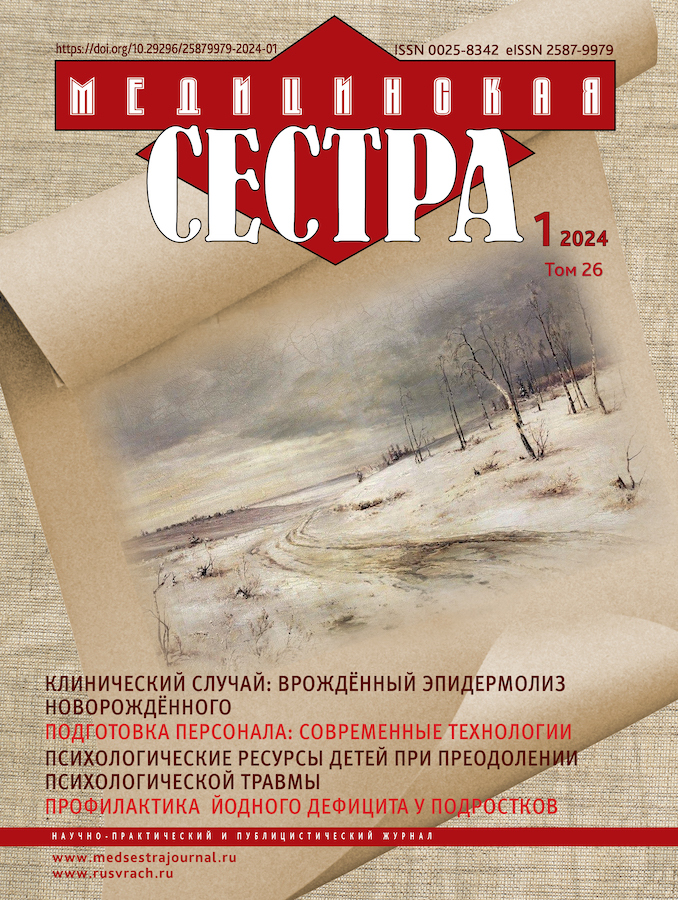Iodine deficiency and modern possibilities of its prevention in adolescents
- Authors: Kurmacheva N.A.1, Chernenkov Y.V.1, Gumenyuk O.I.1, Andreeva A.N.1
-
Affiliations:
- Federal State Budgetary Educational Institution of Нigher Education «V.I. Razumovsky Saratov State Medical University» ofthe Ministry of Healthcare ofthe Russian Federation
- Issue: Vol 26, No 1 (2024)
- Pages: 7-10
- Section: Topical theme
- URL: https://journals.eco-vector.com/0025-8342/article/view/629495
- DOI: https://doi.org/10.29296/25879979-2024-01-02
- ID: 629495
Cite item
Abstract
Iodine deficiency is one of the most pressing problems of modern healthcare. Currently, there are 21 countries in the world where iodine deficiency in the diet of the population has been proven, but has not yet been eliminated. Russia is one of them due to the lack of a legislative framework for mass iodine prophylaxis in our country. The strategy for the elimination of iodine deficiency diseases on the scale of the Russian Federation is based on the adoption of a federal law providing for the use of iodized salt as a medium.
The strategy for the elimination of iodine deficiency diseases on the scale of the Russian Federation is based on the adoption of a federal law providing for the use of iodized salt as a means of population iodine prophylaxis. Currently, less than 30% of the population in Russia consumes iodized salt in their diet, while the target coverage in iodine-rich regions > 90% of households. In 2022, we conducted a survey of 269 adolescents aged 15–17 living in the Saratov Region and found that the share of families who regularly use YS for food was only 24,2%.
Most adolescents rarely eat seafood and do not take iodine-containing drugs, which indicates the ineffectiveness of the «voluntary» model of iodine prevention. In the absence of a federal law, the most important step towards solving the problem of combating iodine deficiency diseases should be the formation of a unified nationwide preventive process based on the appropriate regulatory framework in each constituent entity of Russia – the development and implementation of targeted regional programs for the prevention of diseases caused by iodine deficiency.
Full Text
About the authors
Natalia A. Kurmacheva
Federal State Budgetary Educational Institution of Нigher Education «V.I. Razumovsky Saratov State Medical University» ofthe Ministry of Healthcare ofthe Russian Federation
Author for correspondence.
Email: kurmna@mail.ru
ORCID iD: 0000-0003-2948-9439
Doctor of Medical Sciences, Professor of the Department of Hospital Pediatrics and Neonatology
Russian Federation, SaratovYuriy V. Chernenkov
Federal State Budgetary Educational Institution of Нigher Education «V.I. Razumovsky Saratov State Medical University» ofthe Ministry of Healthcare ofthe Russian Federation
Email: chernenkov64@mail.ru
ORCID iD: 0000-0002-6896-7563
Doctor of Medical Sciences, Professor, Head of the Department of Hospital Pediatrics and Neonatology
Russian Federation, SaratovOlga I. Gumenyuk
Federal State Budgetary Educational Institution of Нigher Education «V.I. Razumovsky Saratov State Medical University» ofthe Ministry of Healthcare ofthe Russian Federation
Email: saroshum@mail.ru
ORCID iD: 0000-0001-5736-9624
Candidate of Medical Sciences, Associate Professor of the Department of Hospital Pediatrics and Neonatology
Russian Federation, SaratovAnastasia N. Andreeva
Federal State Budgetary Educational Institution of Нigher Education «V.I. Razumovsky Saratov State Medical University» ofthe Ministry of Healthcare ofthe Russian Federation
Email: anastena92@mail.ru
ORCID iD: 0000-0002-0031-8815
Assistant Professor, Department of Hospital Pediatrics and Neonatology
Russian Federation, SaratovReferences
- Global scorecard of iodine nutrition in 2021 in the general population based on school-age children (SAC) / Iodine Global Network: [website]. — Text: electronic.–2021.–15p.–URL:https://www.ign.org/cm-data/IGN Global Score-card -2021-7 May 2021.pdf.
- Dedov I.I., Troshina E.A., Platonova N.M. et al. Prevention of iodine deficiency diseases: focus on regional targeted programs. Problems of Endocrinology. 2022; 68 (3): 16–20. DOI: https://doi.org/10.14341/probl13119.
- Troshina E.A. Elimination of iodine deficiency is a concern for the health of the nation. An excursion into the history, scientific aspects and the current state of the legal regulation of the problem in Russia. Problems of Endocrinology. 2022; 68 (4): 4–12. DOI: https://doi.org/10.14341/probl13154.
- Guidance on the monitoring of salt iodization programmes and determination of population iodine status: Russian language version. Clinical and experimental thyroidology. 2018; 14 (2): 100–112. https://doi.org/10.14341/ket9734.
- Abdulkhabirova F.M., Bezlepkina O.B., Brovin D.N. et al. Clinical practice guidelines «Management of iodine deficiency disorders». Problems of Endocrinology. 2021; 67 (3): 10–25. DOI: https://doi.org/10.14341/probl12750.
- WHO, UNICEF and ICCIDD. Assessment of iodine deficiency disorders and monitoring their elimination. 3rd ed. Geneva, 2007. http://whqlibdoc.who.int/publications/2007/9789241595827_eng.pdf?ua=1.
- Suplotova L.A., Gerasimov G.A., Troshina E.A. et al. Assessing of iodine consumption with iodized salt in organized nutrition of children of preschool and school age in the Tyumen region. Voprosy pitaniia [Problems of Nutrition]. 2023; 92 (4): 29–37. DOI: https://doi.org/10.33029/0042-8833-2023-92-4-29-37 (in Russ.).
- Gladkaya V.S., Gritsinskaya V.L. Prevention of iodine deficiency: awareness and consumer choice of the university students. Zdravookhranenie Rossiiskoi Federatsii (Health Care of the Russian Federation).2020; 64 (4): 196–201. (In Russ.). DOI: http://dx.doi.org/10.46563/0044-197X-2020-64-4-196-201.
Supplementary files






